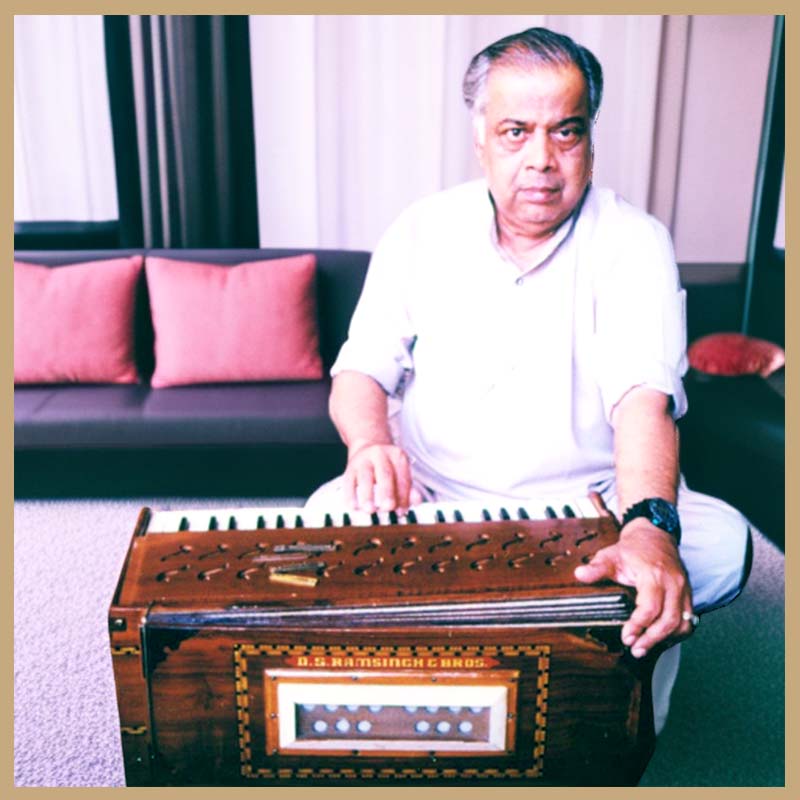



सामान्य श्रोत्यांचे चित्त वेधणारे परंतु बोजदार प्रकार वादकाने वादनात समाविष्ट करावेत. शास्त्राचा बोज व कलेचा तोल सांभाळणे हे वादक कलाकाराला जमले पाहिजे.
पं. विश्वनाथ पेंढारकर
Madhukar Gangadhar Pednekar popularly known a P. Madhukar was born on 27th February 1916 in Mumbai.His initial training in harmonium was from his maternal uncle Shankarrao Rajapurkar and later from Mr,Bahulkar of Mumbai.
His training under Annasaheb Mainkar of Sangli really transformed him.Not only was he exposed to many of of the great artists of those days at Annasaheb’s residence,butalso Annasaheb gave him many new ideas about harmonium playing.Madhurkarrao also assisted Mainkirji in composing music for cinemas and later became a successful music director himself.
Madhukarji’s playing displayed unimaginable speed and forcefulness. He hadsuch mastery over the instrument that he could play it sitting on the side of the bellows or even while holding the instrument upside down. He composed many unique gats in fast temp especially suited for the harmonium. He also devised means of playing the different sitar jhala patterns on the harmonium. There aws therefore an excellent combination of tantakari baaz and gayaki in his performance style.
Madhukarrao played many instruments and started a music class at his residencecalled as the Tansen Sangeet Vidyalaya.He died on 20th July 1967 but left behind noted disciples like Vishwanath Pendharkar, Chandrachud Vasudev,Anant Rane, Datta Jogdande, Lavekar Laxman Kanse and Arondekar Even the harmonium maker Bhagwan Mistry was one of his disciples.
Not many recrdings are available of his performance. Two small clips of about 3 mins each of Raag Shuddha Sarang and a thumri are enough to vouch for his complete mastery over the instrument and Vade jau kunala sharana (Aneesh Pradhan).
Pt Vishwanath Pendharkar was largely a self taught harmonium player but he had the good fortune of learning briefly from the Harmonium Maestro Pt P Madhukar for a period of one and half to two years. This period though brief was a turning point in Guruji's musical journey.
He was a person totally in love with Indian classical and semi classical music. Having had the opportunity to accompany many of the leading vocalists of those days he got a ring side view of how the different rags were developed by each artist. Based on his observations he developed style of playing involving Grace notes. These Grace notes help to give a unique character to each swar when it was used in different ragas. He felt that the fourth finger should be well developed so as to play the grace notes. He event studied piano players and was amazed at the strength even in their little fingers as well as that skill of playing with both hands. He strongly felt that a bada khayal in a slow tempo could be well presented on the harmonium if you could retain the emotional content of the raag. He encourage the students to present khayal in Tilwada or Jhumara which was quite uncommon in those days.
He always insisted that the alap should be unherid and one should extract the maximum joy in short phrases and by staying for prolong periods that is "thehrao" on the prominent Swara of each raag. The slow unfolding of the raag always involved significant pauses where you allow the audience to assimilate the phrases you have presented so far. Another thing he had pick up from the Agra Gharana singers was the nom-tom alapi he used to present this rhythmic form of Aalapi very well. He was totally against random permutation and combination of Swara which he felt only display your dexterity but did not add to the emotional content of the presentation. Among the different forms of taans he considered the sapat taan as extremely difficult type and use to exhaust his students to practice them in at least two or three octaves. He had a unique way of presenting the typical taans of Agra Gharana where some of the notes are repeated as well as stressed as compared to the other notes.
He had a large collection of jhalas which was one of the speciality of his Guru Pandit P Madhukar. He considered semi classical forms like the thumri and dhun and anotch more difficult than classical presentations as these forms needed the highest form of emotional involvement. Hence he taught these forms only to the advance students.
He was always keen to discuss the various aspects of the harmonium with other stalwarts and to understand their points of view. Also he was very much interested in disseminating such information to music lovers in general and especially to harmonium students. With this aim in view he conducted 2 symposia- one a "Shatabdi Sammelan" at Dadar Matunga Cultural Centre and second - the "Harmonium Workshop" at Gandharva Mahavidyalay, Vashi. Fortunately for us a good amount of recording of these symposia are available and we will be displaying them on our website and youtube channel from time to time.